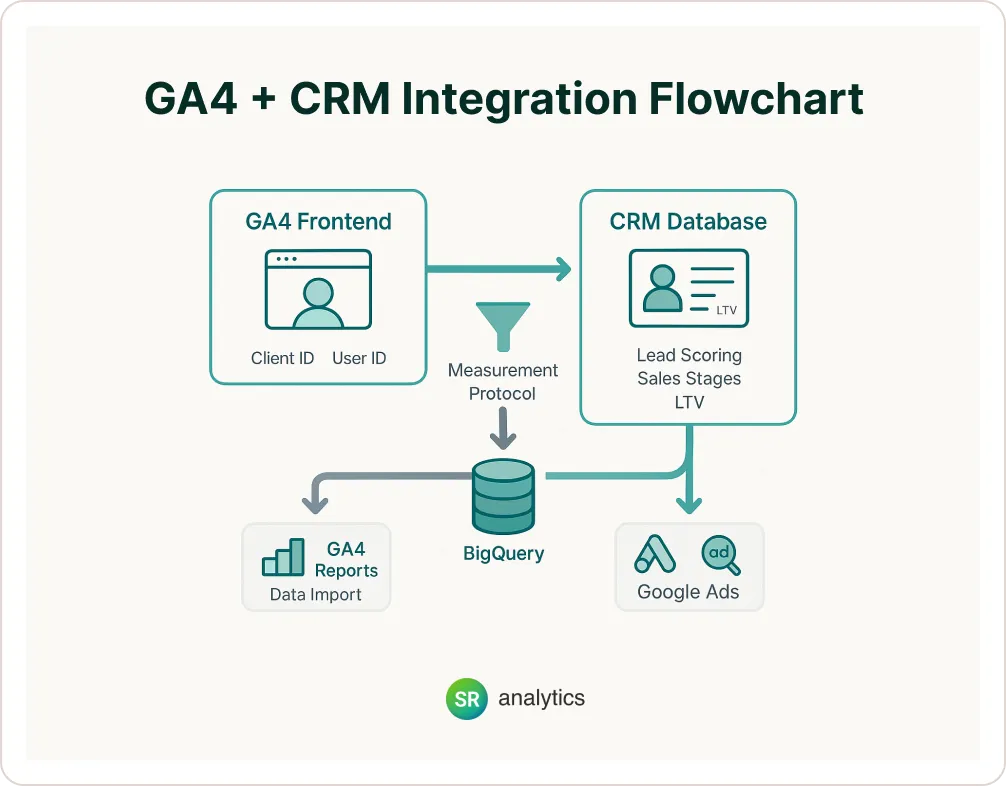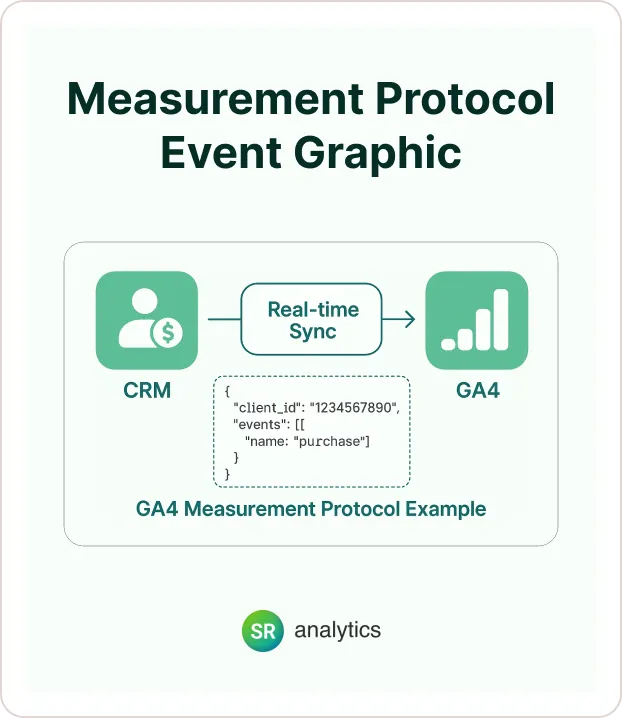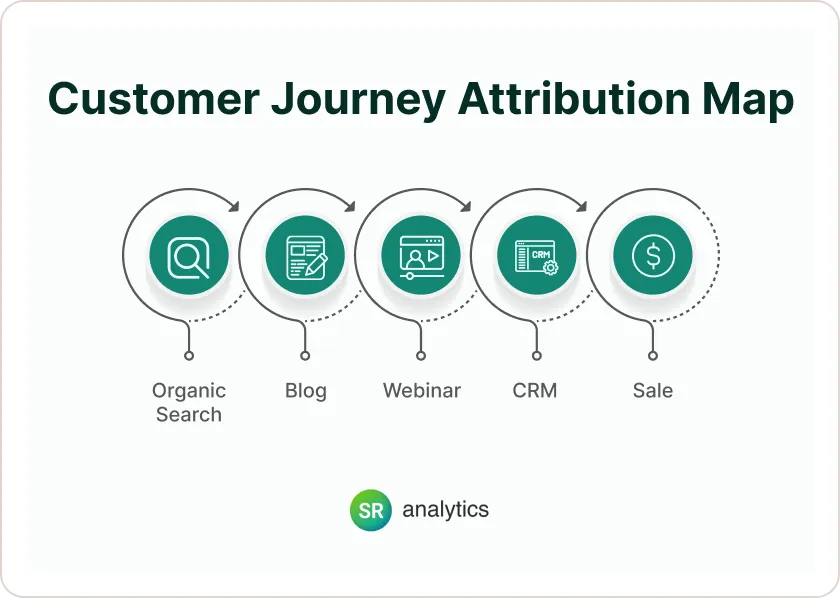Why This Matters for Marketing and Analytics Leaders
If you're a marketing leader, business analyst, or revenue strategist, you've likely experienced the frustration of not knowing which campaigns actually drive revenue.
Google Analytics 4 (GA4) provides powerful event tracking, but it stops short when it comes to real business outcomes like qualified leads, sales pipeline movement, and customer retention.
Why? Because that data lives in your CRM.
Unifying your CRM with GA4 bridges the gap between digital engagement and bottom-line results.
It's how modern businesses unlock full-funnel attribution—attributing ROI to every touchpoint from the first ad click to the closed deal.
In this post, we'll explain what full-funnel attribution is, why CRM integration is essential, how to implement it with GA4 tracking, and what insights you can unlock.
Whether you use Salesforce, HubSpot, or a custom CRM, this guide will show you how to build a more complete view of your customer journey.
What Is Full-Funnel Attribution?

Full-funnel attribution is the practice of measuring the influence of marketing and sales efforts across every stage of the customer lifecycle:
- Top of Funnel (TOFU): Ad clicks, blog visits, video views
- Middle of Funnel (MOFU): Whitepaper downloads, demo requests
- Bottom of Funnel (BOFU): Sales conversations, closed deals
- Post-Sale: Onboarding, retention, upsell opportunities
Implementing full-funnel attribution allows businesses to understand the entire customer journey, from initial awareness to final conversion.
This comprehensive view helps in identifying which marketing channels and touchpoints are most effective in driving conversions.
While GA4 can capture TOFU and MOFU behaviors, it needs help from your CRM to connect events at the BOFU and post-sale stages. Integrating the two systems allows marketers to:
- Attribute revenue to specific campaigns
- Understand lead quality by source
- Identify churn risks
- Optimize for lifetime value (LTV), not just acquisition cost
Want to learn more about how this fits into a broader analytics strategy? Check out our What Is Data Visualization? Blog.
While GA4 enables top- and mid-funnel visibility, let's explore why multi-touch attribution often falls short without CRM integration.
Why Multi-Touch Attribution (MTA) Is Incomplete Without CRM Data
While multi-touch attribution helps distribute credit across touchpoints, it often falls short when powered only by web analytics. Why? Because GA4 can't "see" offline actions or deeper funnel stages like qualified opportunities and upsells.
Without CRM integration, you're likely assigning too much credit to last-click channels or undervaluing nurturing assets like email campaigns or webinars. A CRM-backed attribution model allows you to:
- Weigh each touchpoint based on actual revenue, not just form fills.
- Highlight long-term impact of early-stage campaigns that convert months later.
- Reveal overlooked touchpoints like customer success interactions.
As WhatConverts notes, multi-touch attribution provides the context needed to understand how all marketing efforts work together—not in silos.
Pro Tip: Use BigQuery to stitch together session timestamps from GA4 with lifecycle milestones from your CRM to build custom MTA models.
The Pitfalls of Siloed Analytics and CRM Systems
Here's a common scenario:
- A visitor clicks a Google Ad and lands on your website.
- They fill out a demo request form—GA4 logs a conversion.
- That lead enters your CRM.
- A sales rep follows up, and the lead either closes or doesn't.
But GA4 never knows what happened after the form submission. The data is stuck in your CRM.
This leads to a misalignment between marketing and sales. You may think Campaign A is a winner because it generated 50 leads, but in reality, Campaign B—responsible for only 20 leads—produced most of the revenue. Without CRM-GA4 integration, you're optimizing for quantity over quality.
To improve marketing intelligence across every funnel stage, explore our Marketing Analytics Services.
How CRM Integration Unlocks True Attribution

By integrating your CRM with GA4, you:
- Close the loop: Feed offline events (like SQL or Closed Won) back into GA4.
Integrating GA4 with CRM platforms like Salesforce or HubSpot enables businesses to track offline conversions, enhance segmentation, and optimize marketing strategies effectively.
This integration bridges the gap between online interactions and real-world results, providing a comprehensive view of the customer journey.
- Track real revenue: Assign value to leads, deals, and post-sale transactions.
- Improve targeting: Use GA4 audiences enriched with CRM data to power Google Ads.
- Enhance funnel analysis: Visualize full conversion paths and drop-offs across systems.
By integrating CRM data with GA4, businesses can create highly targeted audiences based on rich customer profiles, past interactions, and purchase history.
This leads to more precise targeting and personalized marketing campaigns.
Popular CRMs like Salesforce and HubSpot support this integration either directly or via middleware platforms like Zapier, Segment, or custom APIs.
If you're in SaaS or B2B, you'll especially benefit from reading our Data Analytics for SaaS Companies page.
Beyond just attribution, syncing CRM with GA4 offers deeper forecasting capabilities—crucial for marketing and finance alignment.
How CRM-GA4 Integration Improves Forecasting and Budgeting
Integrating CRM data with GA4 doesn't just help with hindsight. It sharpens your forward-looking strategies too. Once you understand which campaigns reliably produce high-value leads, you can:
- Forecast revenue pipelines by source and campaign.
- Model ROI scenarios based on historical performance.
- Align budgets across marketing and sales teams using shared metrics.
According to Tatvic, joining GA4 with CRM data enables advanced analytics and predictive modeling that improves decision-making across marketing and sales. MoreVisibility also highlights that integration leads to smarter strategic planning grounded in unified insights.
GA4 Tools You'll Need
Here are the core GA4 features that make CRM integration possible:
1. Client ID and User ID Tracking
Store these identifiers in your CRM during form submissions or login events.
2. Measurement Protocol
Send server-side events from your CRM to GA4 using a secure API. This is ideal for real-time updates like MQL, SQL, or deal stages.
3. Data Import (Offline Events)
Upload CSVs containing historical CRM events like purchases, revenue, or customer churn. Use this for batch updates.
4. BigQuery Export
Join GA4 events with CRM data in a warehouse for deeper analysis and custom attribution modeling.
Once your CRM and GA4 data are flowing together, you're in a position to move beyond reporting—and into predictive insights.
Unlocking Predictive Analytics with Combined GA4 + CRM Data
Once you've unified your data, you can go a step further—into prediction. With tools like BigQuery ML, Data Studio, or Looker:
- Identify behaviors that predict MQL to SQL conversion.
- Detect early signals of churn or upsell likelihood.
- Train models to forecast LTV based on early engagement patterns.
By mapping GA4 behavior patterns (e.g., number of visits, page paths, content viewed) with downstream CRM outcomes (e.g., churn, upsell, renewal), you can proactively act rather than react.
Google's own documentation details how predictive metrics like purchase probability and churn prediction are calculated. InfoTrust further emphasizes how machine learning in GA4 can surface proactive insights that drive revenue—not just reports.
Example: If users who watched a product demo video twice and attended a webinar convert 3x more often, you can trigger nurture campaigns for others who show the same behavior.
Before you dive into the integration process, let's explore the two most common approaches—custom API or middleware.
Integration Approaches: Direct API vs Middleware
Depending on your technical stack, there are several paths to unify GA4 with your CRM:
1. Direct API Integration
Ideal if you have a dev team. Use Measurement Protocol and CRM APIs (like Salesforce REST or HubSpot API) to push real-time events.
Pros: Fully customizable, secure, scalable
Cons: Requires dev resources and ongoing maintenance
2. Middleware Platforms
Tools like Zapier, Segment, Hightouch, or Funnel.io can sync data between GA4 and CRM platforms with minimal code.
Pros: Faster deployment, prebuilt connectors
Cons: Less flexibility, cost may grow with scale
Decision Tip: Use middleware to pilot the setup, then transition to API for scalability.
As Merge.dev outlines, APIs offer precise, customizable data transmission, while middleware is ideal for faster, no-code deployments. Bindbee recommends starting with middleware for MVPs, then moving to APIs for long-term scalability.
If you'd rather see the setup in action, here's a quick walkthrough that shows exactly how the CRM–GA4 connection works. Watching it first will make the steps below much easier to follow.
Step-by-Step: How to Integrate Your CRM with GA4
Step 1: Define Your Funnel Events
Choose the key lifecycle events in your CRM that matter for attribution:
- Demo requested
- MQL, SQL
- Opportunity created
- Closed Won
- Renewal or churn
Step 2: Capture User Identity
Use GA4's Client ID or your own User ID to connect web sessions to CRM contacts. Store this identifier when the lead is created.
Step 3: Send CRM Events to GA4
Use GA4's Measurement Protocol to send events in real time, or Data Import to batch upload them. Include metadata like revenue, sales stage, or lead score.

Example real-time payload:
Step 4: Visualize and Act
Once CRM data is in GA4:
- Use Explorations to build funnel and path analysis.
- Apply attribution models that consider revenue, not just lead volume.
- Build high-value audiences (e.g., Closed Won leads with LTV > $5000).
GA4 offers advanced attribution models that help marketers understand how different channels contribute to conversions.
This understanding enables more informed decisions regarding resource allocation and strategy optimization.
Attribution Modeling with CRM Data

GA4's default Data-Driven Attribution (DDA) model assigns credit based on the most influential touchpoints. But when CRM data is included, the model can:
- Give more credit to early-stage campaigns that led to high-value deals
- Reduce over-attribution to bottom-funnel touchpoints
- Reveal hidden contributors (e.g., blog posts or webinars)
Google Analytics 4's data-driven attribution model utilizes machine learning to analyze up to 50 customer interactions over a 90-day period, assigning credit to marketing touchpoints based on their actual impact on conversions.
This approach offers more accurate insights compared to traditional last-click models.
For more custom analysis, use BigQuery to join CRM revenue data with GA4 sessions and run:
- Linear attribution
- Time-decay models
- Markov chains
- LTV-weighted models
Real-World Example: From Guesswork to Revenue Optimization
A mid-sized B2B SaaS company integrated GA4 with HubSpot CRM using Measurement Protocol.
Before Integration:
- Marketing reported high conversion rates.
- Sales complained about poor lead quality.
After Integration:
- GA4 events included MQL and Closed Won data.
- Attribution shifted credit to previously under-valued channels.
- Campaign budget was reallocated, increasing revenue by 25%.
If you're in B2B tech or SaaS, read how we help companies like yours on our Data Analytics industry page.
As powerful as CRM-GA4 integration can be, it must be done with privacy top of mind.
Related Use Cases: Beyond Marketing Attribution
CRM + GA4 integration doesn't just benefit marketing teams—it adds value across your org.
For Sales:
- Understand lead source context before calls
- Prioritize leads showing high digital engagement
For Customer Success:
- Spot usage trends pre-churn
- Tailor onboarding based on content consumed
For Product Teams:
- See which content or features convert best
- Understand which acquisition channels bring power users
This unified data view can power smarter playbooks across every customer-facing function.
How to Safely Handle Data and Respect Privacy
When combining marketing and CRM data, especially through platforms like GA4, it's essential to ensure compliance with evolving privacy standards. Here are best practices:
- Hash identifiers like email addresses before storing or transmitting them.
- Tag and store consent preferences in your CRM and only sync data from opted-in users.
- Avoid sending PII (personally identifiable information) directly to GA4—even through the Measurement Protocol.
✅ Compliance Tools to Explore:
- Consent Mode v2 for GA4
- Server-side GTM (Google Tag Manager) for better data governance
- Data retention controls in both GA4 and your CRM
Always consult your legal or data governance team before implementing integrations that involve customer-level data.
As Analytics Mates explains, Consent Mode in GA4 helps ensure data collection complies with GDPR and other global regulations. Marcel Digital also recommends regular audits to ensure compliance with evolving privacy frameworks.
Final Thoughts: Why It Matters Now
With third-party cookies on their way out, the value of first-party data has never been greater. Your CRM is a goldmine of post-click data that GA4 can't see—unless you connect them.
By integrating the two systems, you:
- Empower smarter campaign optimization
- Align marketing and sales teams
- Improve customer insights across the funnel
It's not just a technical project. It's a strategic growth move.
If you're ready to unlock full-funnel attribution and turn insights into action, consider working with a Google Analytics agency like SR Analytics. We specialize in GA4 configuration, CRM integrations, and revenue-focused reporting.
Explore more of our capabilities through our Data Analytics Services.














